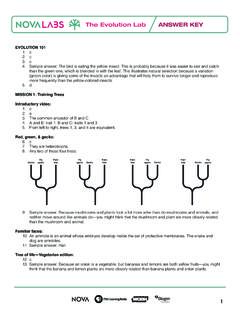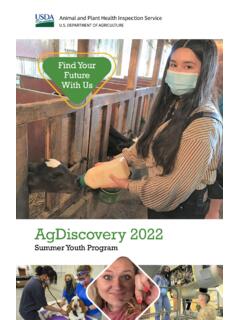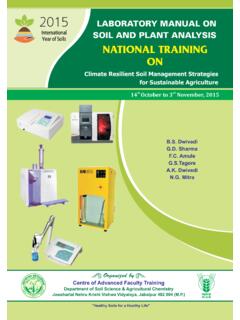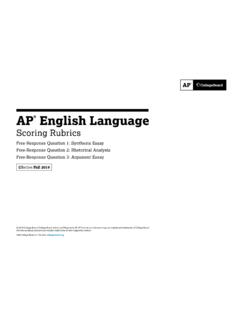Transcription of Algae to Energy Systems Lab Experiments in Growth ...
1 Algae to Energy Systems Lab Experiments in Growth Optimization Overview The concept of utilizing fast-growing, the question: how can we sustainably high-lipid content microalgae to produce produce diesel from Algae in the renewable liquid transportation fuels future? This workshop introduces specifically biodiesel is not new; teachers to bioenergy-related STEM. having first garnered attention in 1960. careers, current hurdles in the Algae -to- Investments by industrial and biofuel pipeline, and invites them to government sectors into green Energy engage their students in addressing the alternatives to fossil fuels over the last complex microbiology, engineering and decade greatly advanced research and design, and socioeconomic challenges technological development of associated with producing biofuel from sustainable, land -based biofuel crops.
2 Microalgae These challenges include, However, at present, the development but not limited to, optimizing algal of novel microalgae biotechnologies is Growth and lipid production, required to realize and evaluate the downstream environmental impacts, and scaled-up, full-potential of microalgal improving production (input/output). Energy Systems future technologic efficiencies. Thus, teachers, and leaps likely conceived or discovered, students, will learn about Algae biology years from now, by present day STEM and how to design simple classroom students. The latter students our photobioreactors with water bottles. future scientists and engineers must Students will then be asked to design a be capable of interdisciplinary studies series of Experiments that manipulate into fundamental biology, Algae Growth requirements to determine bioengineering, chemistry as well as the optimal methods for growing Algae .
3 Logistic and life cycle processing. Thus, Scientific inquiry, engineering, math and in grade 7-12 STEM classrooms, why collaboration will be essential for not explore and, in doing so, impart a photobioreactor success. Systems -thinking approach to address Grade Level This project is designed for students in grades 9-12 in introductory to advanced biology, environmental science and engineering courses and can be modified for student in grades 7-16. Time Frame (Five to six, 45-minute class periods are required for this lab; additional time in class and out of class may be needed). 45 minutes to introduce topic 3-5 days of Growth 1 class period to design Experiments 1 class period to collect data 1 class period to assemble 1 class period to analyze and discuss bioreactors data, and wrap up BTI Curriculum Development Projects in Plant Biology, Algae to Energy , Teacher Manual, 2015 1 Background Biofuels are defined as chemically- Algae are photosynthetic non-vascular processed liquid fuel derived from living plants found mostly in aquatic things, like animal fat or plant matter environments.
4 Some are microscopic, (1,2). In the last decade, research and others are macroscopic. Like dedicated to biofuels, and bioenergy vascular plants, microscopic Algae (syn. production Systems , has increased microalgae), produce and store lipids in remarkably in part due to the the form of TriAcylGlycerols (TAGs). Energy Independence and Security Act TAGs derived from Algae can purified of 2007, which requires a 20% and converted to biodiesel (Figures 1. benchmark reduction in gasoline and 2) via a simple transesterfication consumption by 2017 (3). Title II of reaction in the presence of methanol said act stipulates that the must and an acid or base. increase its overall biofuel production to 36 billion gallons by calendar year 2022, With increasing interest in biodiesel as of which 21 billion gallons must be an alternative to petroleum-based produced from non-cornstarch products.
5 Diesel, scientists are looking to However, ninety-five percent (95%) of microalgae. Algae can be cultivated en first-generation biofuel feedstock crops mass in open ponds called raceway such as corn, rapeseed, palm, ponds or in artificial, enclosed lighted soybean, and sugarcane are also environments called photobioreactors produced for human consumption (PBRs). PBRs offer several advantages (2,3,4,5). This may create a host of over raceway ponds: 1) they reduce the potential problems whereby land and likelihood of contamination; 2) PBRs market for individual food and fuel crops offer better control and optimization of could be in competition with each other. conditions for algal Growth (pH, light, Thus, first-generation biofuel crops, temperature, etc); and, 3) permit higher alone, hold little potential to sustainably cell yields and, hence, greater net yield produce biofuel on the necessary scale biomass.
6 However, PBRs can require to reach future benchmarks (2). more Energy to operate than open pond Systems , depending on the design. BTI Curriculum Development Projects in Plant Biology, Algae to Energy , Teacher Manual, 2015 2 TRANSESTERIFICATION. Fig. 1. (ABOVE) General inputs and outputs within Algae -to-biodiesel pipeline (Courtesy of ). (BOTTOM) Transesterfication of oil to biodiesel (see literature cited, 6); RX are hydrocarbon groups. BTI Curriculum Development Projects in Plant Biology, Algae to Energy , Teacher Manual, 2015 3 Figure 2. Schematic representation of the conceptual Algae to biodiesel pipeline (Figure 1 in [7]). The focus of the classroom photobioreactor laboratory highlighted in RED is to optimize Algae Growth , and hence, overall biomass recovery (BLUE).
7 Water, inorganic nutrients, carbon dioxide (CO2), and light are provided to algal cultures, and cells within the liquid media are separated from the water and nutrient in the biomass recovery phase. The latter nutrients and water are captured and returned (recycled) for use in the Growth of subsequent generations of Algae . From recovered algal biomass, TAGs (oils) are extracted and separated for conversion to biodiesel and other bioproducts. Literature Cited 1. Chisti, Y. 2007. Biodiesel from microalgae. Biotechnology Advances 25:294 306. 2. Suali, E., and R. Sarbatly. Conversion of microalgae to biofuel. Renewable and Sustainable Energy Review 16:4316-4342. 3.
8 6 (110th): Energy Independence and Security Act of 2007. Retrieved from < >. 4. Ahmad, , Mat Yasin, Derek, and Lim. 2011. Microalgae as a sustainable Energy source for biodiesel production: A review. Renewable and Sustainable Energy Reviews 15:584 593. 5. Gasparatos, A., and P. Stromberg. 2012. Socioeconomic and Environmental Impacts of Biofuels: Evidence from Developing Nations. New York, NY: Cambridge University Press. 6. Khan, , Rashmi, S. Parsad, and Banerjee. 2009. Prospects of biodiesel production from microalgae in India. Renewable and Sustainable Energy Review 13:2361-72. 7. Chisti, Y. 2007. Biodiesel from microalagae beats bioethanol. Trends in Biotechnology 26:126-131.
9 BTI Curriculum Development Projects in Plant Biology, Algae to Energy , Teacher Manual, 2015 4 Key Scientific Vocabulary Algae Photosynthesis Photosynthetic plant-like organisms known The chemical process by which organisms as protists. They contain chlorophyll, are convert carbon dioxide into sugars, using fast growing, and can live in fresh, salt, and the Energy from sunlight. waste water. Some types of Algae , like Protists Chlorella, are unicellular and microscopic, Eukaryotic organisms, often unicellular and while others, like seaweed, are multicellular microscopic, sharing certain characteristics and macroscopic. with animals, plants and/or fungi. Biotechnology Raceway Pond Manipulation and development of biological An open system where Algae is grown in organisms, their processes, Systems and large ponds outside that are mixed.
10 Algae components to make useful products, concentrations in these Systems are and/or understand basic biological typically not as high as in photobioreactors, processes, often by means of genetic but the Energy required to maintain the engineering. system is typically lower than the Energy Biodiesel required to maintain photobioreactors. A biodegradable transportation fuel that can Strain be used in diesel engines. Biodiesel, a fatty A variety of species that is relatively uniform acid methyl ester, is produced through genetically because of continued inbreeding transesterfication of oils or fats from plants and artificial selection. Certain characters or animals.







